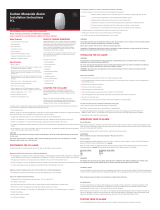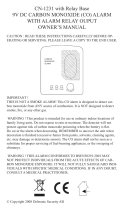
2. Carbon Monoxide – The Silent Killer
2.1 What is Carbon Monoxide ?
Many people are killed each year, and many more suffer ill health from Carbon
Monoxide (CO) poisoning. CO is an invisible, odourless, tasteless and extremely
toxic gas. It is produced by appliances and vehicles burning fuels, such as coal, oil,
natural/bottled gas, paraffin, wood, petrol, diesel, charcoal etc. CO is absorbed by
red blood cells in the lungs in preference to oxygen - this results in rapid damage
to the heart and brain from oxygen starvation.
High levels of CO in a house can be caused by:
• Incorrectly or poorly installed fuel-burning appliances.
• Blocked or cracked chimneys/flues.
• Blocked vents or draught-proofing which makes areas with fuel burning
appliances or fireplaces airtight.
• Engines of cars, lawnmowers etc. left running in confined spaces.
• Portable paraffin or gas heaters in badly ventilated rooms.
2.2 What happens when your CO Alarm detects Carbon Monoxide ?
When the Alarm detects potentially dangerous levels of CO, it flashes the red alarm
light immediately and then sounds a loud alarm if the CO persists. Table B-1 & B-2
below shows how the CO Alarm reacts to different levels of CO gas and exposure
time. At higher levels of CO the Alarm turns on sooner. The rate of flashing of the
red light indicates the level of CO. If your CO Alarm sounds follow the instructions
in section 6. NEVER IGNORE THE ALARM !
5





















